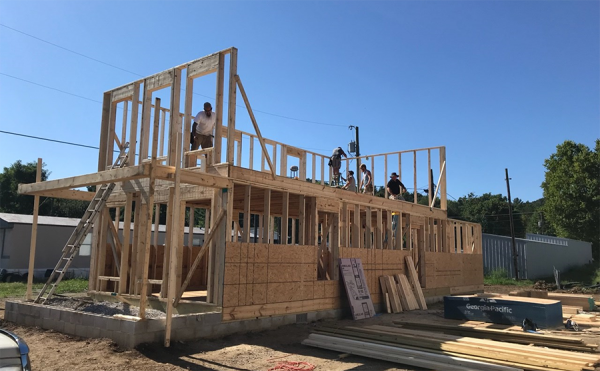The Impact of the PRO Neighborhoods Program on Underserved Communities
Community Development Financial Institutions (CDFIs) that received grants from JPMorgan Chase & Co.’s ambitious Partnership for Raising Opportunity in Neighborhoods (PRO Neighborhoods) initiative in 2014, 2015, and 2016 dramatically expanded their financial activities in low- and moderate-income communities, according to a 2018 progress report on the program that I co-authored with Alexander von Hoffman, a senior research fellow here at the Joint Center for Housing Studies.
Our report found that these CDFIs — mission-driven organizations that lend money to help residents of disinvested communities — have so far made 21,000 loans totaling more than $411 million, which have helped create 3,000 units of affordable housing and also helped create or retain 11,000 jobs. In addition, the awardees used the funding to leverage an additional $713 million in financing, and in doing so helped pump an additional $442 million of outside money into community development projects.

The Urban-Rural Kentucky Collaborative, a 2015 PRO Neighborhoods Awardee, helps owners of manufactured housing in rural Kentucky to build new, up-to-code houses, like the one pictured here.
The report is the latest in a series produced by the Joint Center about the initiative, a five-year, $125 million annual grant program that since 2013 has given three-year grants to groups of collaborating CDFIs that use innovative methods to address the problems of distressed neighborhoods. The progress report, which was released in conjunction with the Opportunity Finance Network Conference, an annual gathering of CDFI practitioners, highlighted the ways that collaboration — both among CDFIs and between CDFIs and other entities that share similar community revitalization goals — can help CDFIs and others increase their impact in the communities they serve.
The awards also helped CDFIs build their capacity, the report shows, with an average increase in lending of nearly $5 million and, on average, the addition of four new employees, as reported by the 2015 awardees in the first two years of their collaborations, which is a faster pace of growth than other CDFIs over a similar period. At the event where the report was released, Calvin Holmes, president of the Chicago Community Loan Fund (CCLF), recounted CCLF’s growth since it became part of a consortium that received a PRO Neighborhoods award in 2014. Since that time, CCLF has doubled in size and developed the organizational capacity to lead a 2016 awardee collaboration. Following on those successes, CCLF helped one of 2018’s successful applicants develop its collaborative strategy and PRO Neighborhoods proposal.
The progress report also found that recipients of PRO Neighborhoods awards employed a variety of strategies to invest in underserved communities. They formed new collaborations that accelerated loans to small businesses in areas previously neglected by the financial industry, concentrated their impact by aiming a range of community development efforts at particular neighborhoods, and spanned great distances to bring knowledge, methods, and capital to disadvantaged communities.
All of the PRO Neighborhoods awardees are working to create more equitable access to credit, and several specifically support women-led CDFIs, target women and minority groups, and bring CDFI lending to underserved areas, including impoverished rural areas. Indeed, according to data collected from the 2015 and 2016 cohorts of awardees, PRO Neighborhoods collaborations gave 66 percent of their loans to low- and moderate-income borrowers. In addition, more than 68 percent of loans went to women, and 28 percent went to minority borrowers, including 41 percent of small business loans.
PRO Neighborhoods awardees also devised innovative ways to do business, including creating new technology for lending and homebuyer counseling, and mining demographic and economic data to discern community needs. Through the program, CDFIs have increased the scale of their operations, by sharing new loan products with partners in other states, replicating successful revitalization strategies in new areas, and organizing CDFIs state-wide to advocate for better community development policies.
These experiences offer several lessons for the community development field. Most notably:
- To address the multifaceted needs of a particular community, practitioners need to consult not only experts but also members of that community. Leaders should plan to start early to engage community residents.
- To achieve broad-based community development, it is essential to find allies that will complement and strengthen each other. Once found, partners must build trust and communicate regularly.
- CDFIs should strive to learn from peer institutions for both organizational development and connection to the community investment network. CDFIs benefit from sharing best practices, helping collaborators face challenges, and closely observing each other’s methods.
CDFIs are in a unique position to inject capital into underserved communities, noted Lisa Mensah, president and CEO of the Opportunity Finance Network at the organization’s conference. Earlier this year, she recounted, she was asked at a Congressional hearing on the innovation economy, what could be done to support innovation in the vast majority of communities that lack venture capital funding? The answer, Mensah declared, is clear: support CDFIs, the experts at getting capital to underserved areas. The PRO Neighborhoods program, according to our report, indicates that enhancing the capital of CDFIs and encouraging collaboration can increase their ability to do this critical work.

